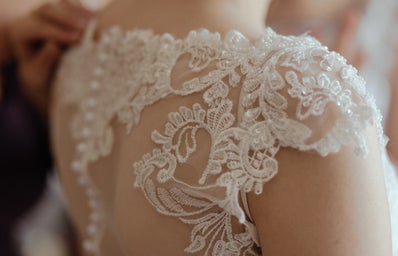In a culture where fast fashion reigns supreme, the allure of a brand-spanking new wedding dress can be tempting. However, amidst the glitz and glamour lies an equally fabulous, yet more conscientious, option. The future of bridal shopping is saying “I do” to secondhand wedding dresses.
Young women who grew up on the “Say Yes to the Dress” fantasy generally have one idea of how wedding dress shopping goes: a bride walks into a fancy boutique like Kleinfeld, where any budget under a few thousand dollars is laughable, and tries on a million straight-from-the-showroom dresses until she inevitably goes over budget for a custom-fit designer gown. Though this narrative is a fairy tale for some, it is a nightmare for others. This vision isn’t always attainable or sustainable, so typical bridal boutiques just aren’t cutting it anymore.
Emmali Osterhoudt, an Alabama Southern belle, has fantasized about wedding dresses since she was five. Her dreams unexpectedly materialized when she discovered a $6,200 lace designer mermaid gown, which fit perfectly, at Goodwill for less than 1% of the original price. Her discovery occurred three months before she even had a rock on her hand. Wedding dresses typically require rounds of expensive alterations and customizations, but her incredible luck made her feel like the chosen one.
“After I thrifted my dress, I thought, ‘Why wouldn’t people get more secondhand wedding dresses?’” Osterhoudt said. “You wear that dress for a few hours, and you get pictures in it, but you’re never going to wear it again. A lot of these wedding gowns are $5,000 to $12,000 for one day. And if you can afford that, that’s fantastic and amazing, but a lot of people can’t.”
Osterhoudt could afford a dress from Galia Lahav, the designer for Paris Hilton and Beyoncé’s wedding dresses, because she explored second hand. Her experience was so surprising and inspiring she amassed more than 5 million views on TikTok and interviews with “Good Morning America,” ABC News and “People” magazine.
In addition to affordability, modern brides prioritize sustainability. Azazie, a leading bridal fashion company, found in its annual report for 2023, 42% of brides are considering eco-friendly or sustainable options for their weddings. According to Evergreen Bridal Studio, a sustainable bridal fashion company, fashion is currently the second most polluting industry in the world. Each wedding gown emits 10 to 20 kilograms of carbon emissions, putting them on the high-polluting end of fast fashion. Purchasing a dress to wear only once can be considered environmentally irresponsible.
Though Azazie only has the statistics on the perspectives of 2023 brides, bridal sustainability isn’t a new concept. “In past cultures women would spend a lot of money on a wedding dress, and they would wear it for all major events…They would get a dress and wear it five or six times a year,” said Gretchen Blair, who owns The Wedding Cycle, a popular secondhand wedding dress store in Gainesville. The shop’s inception stemmed from a dream of the original owner, who envisioned throwing wedding dresses into a recycling bin.
Above the shop’s office hangs a 12-by-16-inch photograph of a bride in a tea-length ball gown with cap sleeves and an illusion neckline. That bride is Blair’s mother, who got hitched in 1958 and is a prime example of bridal sustainability. “That dress was passed around all through her sorority,” she said, gesturing to the iconic picture. “Wedding dresses weren’t always meant to be worn just once, and I think that is going to come back.”
Blair despises the prevailing culture around wedding dresses. “If your wedding anniversary is on a Wednesday, wear that [damn] dress at home with your husband. Wear the dress. Be a princess with your daughter on Halloween, and if you’re not going to wear the dress, then sell it to me so someone else can love it!”
There are endless reasons to consider alternatives to traditional boutiques. Experts recommend three sustainable bridal-shopping options: thrifting, specialty boutiques and sourcing from other brides.
Thrifting a wedding dress is often the most challenging of the options, but it is also the most rewarding intrinsically and monetarily. Because most thrift stores, like Goodwill or Salvation Army, don’t specialize in bridal attire, it is beneficial to check out the limited and ever-changing selection whenever you have the chance.
When Osterhoudt found her one-in-a-million gown, she had just finished shopping for picture frames when her friend directed her attention to the wedding dress section. “Whenever she pointed this out, I thought she was talking about the ’80s wedding dresses everyone’s grandma donates,” Osterhoudt said. “So, I just wandered over to see what they had, and I found a dress that looked like it was my size and looked really pretty.”
Blair says that this is the case for most thrift stores: older gowns that might be out of style, but there are diamonds in the rough.
“You have to know what to look for,” Blair said. Beyond simply liking a dress, it is important to check its condition. She suggests examining the front of the dress for stains, as pictures will be mostly taken there, and checking the often-forgotten bottom of the dress for grass stains. Most dry cleaners refuse to clean wedding dresses due to liability concerns, so stains can significantly impact a dress’ value.
“If there’s a tear in the tulle at the back of the dress, something like that is very easy to fix. But if there is something up front, I wouldn’t pay for the dress,” Blair said. Due to the high-quality materials used in making wedding dresses, the mending process is much more complicated.
Her final tip is to check out thrift stores in affluent areas. That is where people typically find the highest-quality items.
Thrifting a wedding dress often requires more effort, but Osterhoudt thinks brides should give it a try.
Osterhoudt also reveals after her viral video, designer Galia Lahav was so moved she donated several of her dresses to Goodwills across the country. “So, if you are a bride thrifting for a wedding dress,” Osterhoudt said, “I would definitely keep an eye out for that.”
Specialty wedding boutiques curate vintage, secondhand, consignment and off-the-rack options all in one place. Every alternative boutique has different styles and priorities, but each offers at least two standard options.
Vintage wedding dress stores offer the benefits of beautiful secondhand dresses without the need to rifle through less specialized thrift stores like Goodwill or Salvation Army. If a bride wants a unique option, vintage is the way to go.
“Some dresses come with stories. Some come with photos. Some come with grandparent or sibling dresses, and that is kind of my favorite,” Blair said about the vintage gowns in her shop. The charm and history available at stores like The Wedding Cycle are hard to find at a traditional boutique.
Off-the-rack or sample-sale dress shops provide brand new gowns you can take home the same day. These dresses didn’t sell in larger boutiques, allowing sale shops to significantly mark down prices. Additionally, boutiques hold annual sample sales featuring dresses they will no longer stock.
The last spot to get your perfect dress is straight from other brides. On Facebook, there are groups made for brides to exchange and buy wedding dresses. Brides can find dresses in every style, from mermaid to ballgown, with a variety of sizes and embellishments. The group “Wedding Dresses for Sale” has 45,800 members and several posts per day announcing items for sale. A quick scroll shows wedding dresses ranging from $50 to $30,000.
If you’re worried about bad energy from a wedding gone badly, Blair says almost every bride she has encountered looking to sell her dress either happily wore it or found a new dress she prefers.
Whether a dream dress was found in a vintage boutique, a pre-loved marketplace or a heartfelt exchange with another bride, the choice is a toast to the beauty of second chances and the values of a modern bride. Make it a “happily ever after” for you and your planet.


